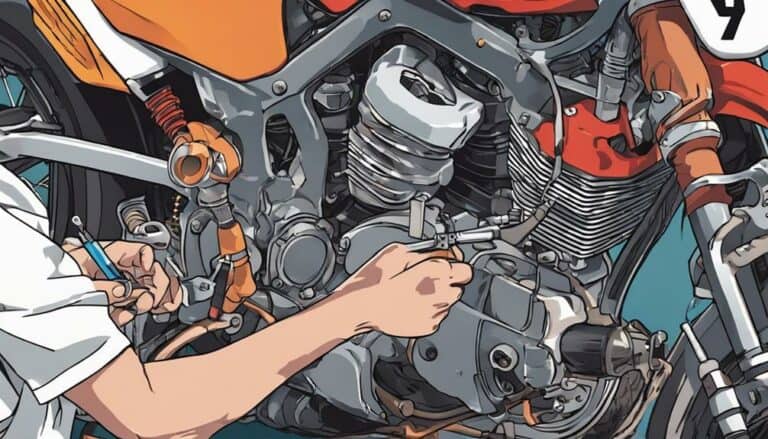If you're looking to prevent your dirt bike from running, did you know that dirt bike theft is a significant issue, with thousands being reported stolen each year?
Now, to guarantee your bike stays put when you want it to, there are various methods you can utilize. From disconnecting the spark plug to disabling the ignition system, each step plays an important role in safeguarding your dirt bike.
Stay tuned to discover the most effective ways to keep your dirt bike secure and protected.
Key Takeaways
- Disconnect the spark plug or ignition system to prevent engine start.
- Drain fuel from the system to ensure the bike won't run.
- Remove the carburetor to immobilize the bike effectively.
- Secure the throttle with a lock to prevent unauthorized use.
Disconnecting the Spark Plug
To disable a dirt bike quickly and effectively, start by disconnecting the spark plug wire from the spark plug. This process involves locating the spark plug, typically found near the engine's cylinder head. The spark plug wire is usually a thick, insulated cable connected to the top of the spark plug. By carefully pulling the spark plug wire away from the spark plug, you interrupt the ignition system, preventing the engine from starting.
Disconnecting the spark plug effectively stops the flow of electric current needed to create a spark for combustion within the engine. As a result, the dirt bike won't be able to start or run. This method is a straightforward way to immobilize the bike temporarily, whether for maintenance, storage, or security purposes.
Reconnecting the spark plug wire is equally simple and allows you to restore the dirt bike's functionality promptly when necessary. This technique is commonly used by riders to prevent unauthorized use or as a safety measure to keep the bike stationary.
Draining the Fuel System
When draining the fuel system of a dirt bike, locate the fuel tank and disconnect the fuel line from the carburetor. Here's how to effectively drain the fuel system:
- Prepare a Container: Before disconnecting the fuel line, have a container ready to catch any fuel that may spill out. This will help guarantee no mess and ensure safe disposal of the fuel.
- Drain the Fuel: Once the fuel line is disconnected, proceed to drain any remaining fuel from both the tank and the carburetor. Make sure to empty all the fuel to prevent the dirt bike from running.
- Dispose of Fuel Properly: After draining the fuel system, guarantee there's no residual fuel left. Properly dispose of the drained fuel following local regulations to prevent environmental harm.
Removing the Carburetor
Removing the carburetor from your dirt bike requires careful disconnection of the fuel line, throttle cable, and other connections near the engine and air filter box. To begin, locate the carburetor, typically positioned close to the engine. Using the appropriate tools, loosen and remove the mounting bolts or clamps securing the carburetor in place.
Take caution to detach the carburetor meticulously, paying attention to how it's connected to the bike's intake and fuel system. Make sure you keep track of the position of all parts for reinstallation purposes. Once the carburetor is removed, store it in a safe location to avoid any damage.
Disabling the Ignition System
After removing the carburetor, the next step in disabling your dirt bike involves taking measures to interrupt the ignition system. Here are three ways to accomplish this:
- Disconnect the spark plug wire: By disconnecting the spark plug wire from the spark plug, you prevent the spark from igniting the fuel-air mixture, effectively stopping the engine from running.
- Remove the ignition coil or CDI unit: Interrupt the electrical signal needed for spark generation by removing the ignition coil or CDI unit. This will prevent the ignition system from functioning properly.
- Short-circuit the kill switch wiring: To stop the engine from starting, you can short-circuit the kill switch wiring. This action prevents the circuit from completing, ensuring the engine remains off and inoperable.
Securing the Throttle
To guarantee the immobilization of your dirt bike, securely fastening the throttle is an important safeguard against unauthorized operation. One effective method is to utilize a throttle lock or throttle grip lock. These devices serve to prevent the throttle from being twisted, thereby disabling the bike's ability to accelerate.
Installing a throttle grip lock physically obstructs the throttle, acting as a visible deterrent to potential thieves or unauthorized users. Throttle locks come in various designs and are easily mounted on the handlebars, making them a simple yet efficient way to immobilize the throttle.
Conclusion
To render a dirt bike inoperable, simply follow the steps outlined above. By disconnecting the spark plug, draining the fuel system, removing the carburetor, disabling the ignition system, and securing the throttle, you can effectively prevent the bike from running.
Just like a skilled mechanic dismantling a finely tuned machine, you can guarantee that the dirt bike remains stationary and secure.

